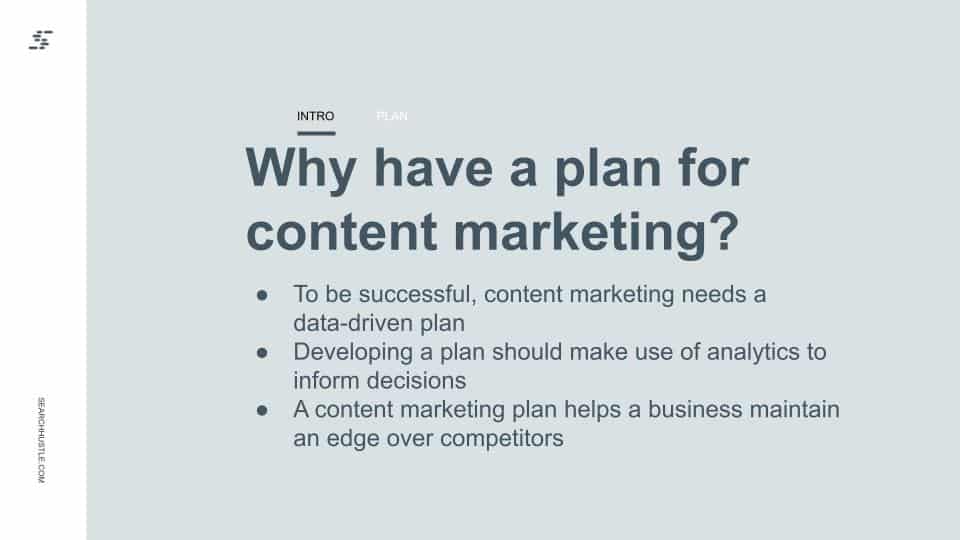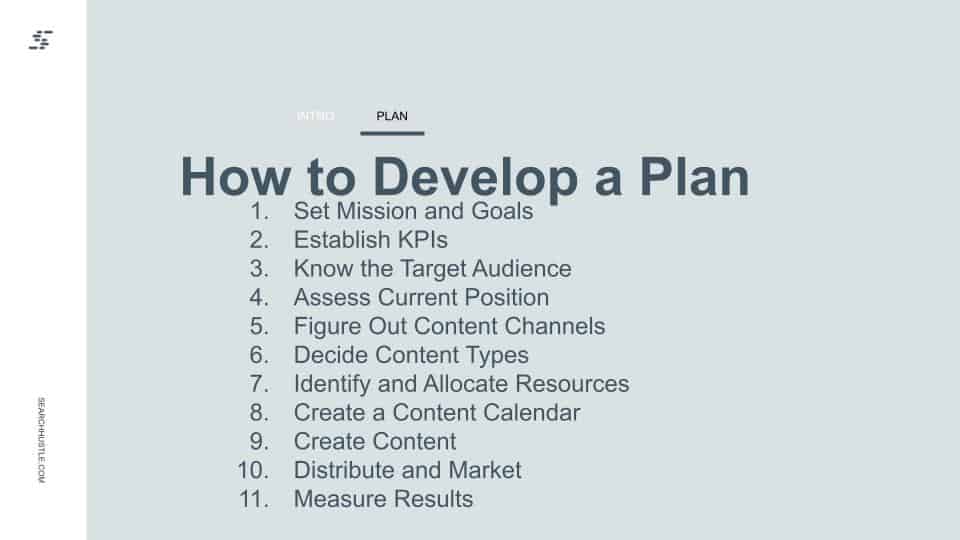Developing a Plan
Moving content marketing forward with no plan can lead to waste and mistakes.

Your business must have a solid content plan to maintain an edge against competitors and keep the target audience engaged.
According to Benjamin Franklin, “By failing to prepare, you are preparing to fail.” Through research and planning, a business can ensure its content strategy succeeds at driving organic traffic and generating inbound leads. Do not try and fast-track or shortcut this process. Think of it as the essential groundwork that needs to be done to ensure you have solid foundations for the future.

Set Your Mission and Your Goals
The first step to laying out a solid foundation for any content plan is deciding on the overall mission and goals.
The mission statement is there to help ensure all content created serves a defined purpose. The mission statement should outline factors like the target audience, the types of content used to reach the target audience, and the benefits the target audience will derive from the content.
The formula to create a mission statement for a business can be broken down as such:
At [COMPANY NAME], we provide [TARGET AUDIENCE] with [TYPE OF CONTENT] to help them with [BENEFICIAL OUTCOME].
After that, you should also define any goals associated with the business. Some of the most common goals include:
- Growing brand awareness
- Increasing sales
- Gaining organic traffic
- Improving revenue
- Boosting social media engagement

Establish Your KPIs
You must use key performance indicators (KPIs) to know whether goals are being met. This helps keep all goals specific and measurable.
For example, you could set a goal to gain 10,00 new email subscribers in a month or increase web traffic by 5% after ten days.
Some common KPIs that businesses choose to track include:
- Unique page visits
- Number of downloads
- Time on page
- Amount of inbound links
- CPC, CPL
- Lead generation
- Conversion rates
- Bounce rate
- Social shares
Know Your Audience
Knowing your target audience is key to creating relevant and valuable content that will resonate with them. There are three key reasons to define a target audience:
- Create the right content for the right people.
- Gain a deeper understanding of what benefits the content should provide to the target audience.
- Increase conversions.
There is data you can analyze to pull in to frame a target audience.
Research the demographics
The first factor a business needs to establish is its customer demographics. This can be collected from web, email subscription, and social media analytics.
The data collected should include:
- Age
- Gender
- Income
- Education
- Key interests
Look at both quantitative and qualitative data. By identifying the key characteristics of current customers, a business can better understand who they should create content for.

Receive customer feedback
You can gain key insights by collecting feedback from customers. By surveying its customers, a business can begin to understand what it’s doing well, what requires improvement, and the type of information customers want from the company.
Construct buyer personas
Once demographic data and customer feedback have been collected, the audience should be segmented to create buyer personas. This will help the business create personalized content to meet the wants and needs of each group or segment.
The buyer persona should include the following information about the customer:
- Pain points
- Goals
- Values
- Behavioral motivators
- Preferred social channels
- Position in the sales funnel
- Job title and role
- Age
- Gender
- Marital status
Assess Your Current Position
When a business already has some content published, it’s a good idea to look into whether it is helping to meet any goals or not. Performing a content audit will help with this.
A content audit is when a business analyzes all its content, from blog posts to videos to social media posts. By conducting a content audit, a company can discover:
- Strengths and weaknesses in the content strategy
- Which content can be repurposed
- Content gap opportunities
- Popular keywords within the content
Performing a content audit can be pretty time-intensive. It typically involves tasks like logging all content pieces, assessing each piece’s effectiveness, comparing it against competitors, and more.
Figure Out the Best Content Channels
After creating buyer personas and performing a content audit, a business should start to get a general idea of where its target audience hangs out.
To double-check this information, a business should make use of Google Analytics. This web analytics tool can show the various social networks where content is being shared on.
With this data in hand, a business should choose the platforms that are performing the best and target those for social media engagement and shares for content.
Decide on Content Types
There are a myriad of content formats to choose from for a business. Examples of just a few include:
- Case studies
- ebooks
- Email newsletters
- Infographics
- Webinars
- Interviews
- White papers
- Vlogs
- Videos
- Surveys
- Slides
- Podcasts
However, instead of randomly choosing a format, a business should instead take the data it has gathered thus far from its target audience research and content audits to decide what format will work best.
The most popular approach is to publish blog posts to the company website and then to repurpose and share this content to other sites.
Identify and Allocate Resources
Even high-quality content can flounder if there’s no plan in place.
Depending on the business size, you should allocate roles that set out who is in charge of content production and those responsible for delivering each content piece. For instance, some companies produce content in-house, while others outsource content creation to freelancers or marketing agencies.
Next, a business needs to know what human, digital, or physical tools and resources it needs to produce content. For example, if your business wants to start a YouTube channel, your company might need to purchase equipment for its in-house team or SEO software such as TubeBuddy.
After that, you should clearly define the content production process. So, for a blog post, the process might look like this:
- Create an outline or brief
- Have the outline approved
- Write the post
- Add images
- Have the post edited
- Get approval on the post
- Upload
- Publish
- Promote
- Engage with comments
By ensuring a content-production process is in place, a business can help streamline content creation and consistency.
Create a Content Calendar
No content plan is complete without a content calendar. A content calendar lets you map out when and where to publish content. Without a content calendar, you can easily fall into the procrastination trap.
You can use several tools to help create a content calendar, such as Google Calendar, Sheets, CoSchedule, Asana, and Monday.
When creating a content calendar, use the examples below to help you know what type of information to include:
- Ideas for content
- Content topics
- Focus keyword cloud for each post
- Assigned writers, editors, publishers, and schedulers
- Publish dates
- Content channels to post on
Ultimately, it is up to you to decide how detailed the content calendar is. It should achieve the desired result if it streamlines workflow and ensures consistent production and publication.
Create Content
Once all the prior research has been done, such as understanding the target audience and the goals of the business, then you should have a firm grasp on what type of content needs to be created. For example, maybe you now know, in certain spaces, customers prefer blog posts of over 1,500 words that provide how-to information.
Once you know what topic to tackle, keyword research should be the next step before diving in. Identifying keywords will improve the SEO of the content and improve its search ranking. Knowing what keyword to prioritize while writing a blog post, for example, will impact what direction the content goes.
Also, be sure to consider what type of tone should be set for the content. The tone used for the content should help reflect the brand’s personality.
Create Principles
In seeking to improve on-page SEO and produce content that enhances the ability to rank against queries – consider best practices. While learning about the other areas of SEO is important, content can truly drive a website from the bottom to the top. Here are the essential practices to incorporate into the content creation process.
Content Strategy and Research
Search engine optimization must be strategic. Throwing darts at a wall and hoping they stick is no way to optimize a site and generate revenue. Instead, everything you do should be intentional and measurable, with a specific goal.
Content research answers questions about how the content works for those who use it. It helps build a deeper understanding of who uses the content and its place in their world. Content research looks at the hierarchy of content, tagging, and other internal processes.
Authoritative and informative content requires research. So if the goal is to answer the right questions and have the right content for the audience, then some research will be involved.
The Process of Content Research
To begin your content research, try to get an idea of the number of online articles or pieces of content for a specific topic or keyword phrase. This includes your content and the top content generated by a web search. Then, check SEO tools for traction, social engagement, and other traction statistics.
List the topics in those articles and identify any gaps in the information provided. Always answer frequently asked questions in your content. As you evaluate the pieces, consider their angles, length, keyword targets, slug structures, visuals, and anything else relevant before starting.
Create a List of Topics
The first step is to get a general idea of what you want to write about. For instance, a company selling shooting targets could also write about guns, ammunition, new policies affecting shooting hobbyists, gun safety, etc.
A dentist can write about routine checkups, dental bridges and implants, emergency procedures, root canals, crowns, Invisalign (or other brands), braces, etc.
Fully flesh out everything in your space that could attract relevant traffic and leads.
Know Your Market
Knowing the market is incredibly important. Each facet of the market has different customers with different habits. Understanding the market thus allows for products to be sold that have a better chance of aligning with your audience.
Know Your Audience
While this may seem obvious, many people make mistakes when writing content for their audience. Content should address questions, concerns, or specific intricacies of the industry. Articles shouldn’t just be used as a selling tool for products or services offered by a business. Rather, they should encompass a specific audience’s broader area of interest. For instance, a pool company might have blogs on swimming and common pool issues, not just about their products. It all comes back to taking a value-first approach, trying to help people, providing answers to questions, and even facilitating them learning something new. Trust me, they’ll remember you for it.
Remember that a top priority for search engines is “search intent.” Therefore, work to provide content that matches up against the intent behind a query.
This is one way a company can present itself in a positive, empowered light. Don’t be afraid to assert authority and topical leadership. The content should propel a company to the point of industry-leading authority and not just focus on their products and services.
Informative articles that consider the target audience’s knowledge base will often be successful. Because people who are into or looking for something are often eager to learn more about it.
Do not overcomplicate the subject matter or make it too abstract. You don’t want to come off as sounding smart unless you are in a niche field. You want your audience to feel smarter after reading your content. Therefore, convey your thoughts as clearly and concisely as possible. Always try to write conversationally, and keep it as close to your authentic self as possible. People enjoy reading posts that come across naturally. When you start to sound stuffy, impersonal, or overly dry, you risk people tuning out and disengaging.
Quality content includes having good grammar, punctuation, spelling, and correct information. However, it also needs to be engaging and easy to read. Producing content like this should result in better SERP positioning and Google deciding to share it more often because users find it valuable.
In digital marketing, quality content is content people want or need because it is informative, entertaining, or authoritative. The content answers people’s questions accurately, and the information can be shared, liked, or quoted, giving a website perceived or measurable “authority” on the subject.
Know Your Competitors
Do you know who is competing for a share of the market? What do they bring to the table, and how does the market react to them? It is possible to learn a lot about what to do and what not to do by doing content research on competitors, AKA gap analysis. Plus, the more information available, the more superior choices you can make about your approach.
Identify the Networks Where Your Audience Shares Content
Where does the audience being reached by the content visit first before they share this content? Which social media platforms do they use? With this information, you can learn which platforms are best and focus your time and attention on the channels that will drive the highest ROI and impact.
Identify Social Influencers and Digital PR Opportunities
Find out what social influencers are popular within your target location and demographic on the networks used by the audience. Each area of a network has its hierarchy and trusted influencers. Therefore, becoming familiar with these market professionals and subsequent opportunities is essential.
Keyword Research
Conduct the research. Analyze the competition. Ensure you use the same terms people use to search for their needs. Don’t use technical language if your target audience is the layman who needs your services but doesn’t know much about them. Don’t use layman’s terms if your target audience is fellow professionals who expect authoritative content.
Track the Competition’s Keywords
Whether a small-town restaurant or a national retailer, knowing your rival’s keywords is important. Just like you analyze their prices and operational strengths and weaknesses, you should also monitor their keywords.
Tools like Answerthepublic, BuzzSumo, SEMRush, AHREFS, Google Keyword Planner, and SpyFu can help you conduct a competitive analysis of the sites you want to emulate. These tools will give you an idea of which keywords they’re attacking. You can then take that information and look for opportunities to beat them at their own game.
Tracking Your Success
Google Search Console (accessed via Looker Studio) is one of the most valuable and accessible SEO keyword tools. The Search Console performance report tells you which of your pages generates the most impressions and clicks, along with the average position in the SERPs and the click-through rate.
The performance report also tells you which pages are most valuable and those which need to be beefed up with additional content or optimized to improve their ranking. If you’re like us, you look at this data daily or have this information piping into a larger report in Google Analytics, Looker Studio, Amplitude, or Tableau.
Build Pages for Each Topic (Keyword Cloud)
Build a primary page for each topic you want to rank for. Make sure the pages aren’t competing with each other by keeping them in scope. Optimize the pages through URLs, headers, metadata, images, and videos that utilize the target keyword/keyword cloud.
Distribute and Market
After content creation is finished, the next step is to ensure it is published onto the appropriate channels and advertised. Where the content is being published should already be decided during the content calendar planning phase.
For example, once a new blog post goes live on the company website, perhaps it will be mentioned in an email newsletter that goes out weekly. This helps to engage subscribers who have already shown an interest in content from the business. Making a post on Twitter about the latest blog post or directing a new site visitor to the latest blog post can also help to market the content.
Measure Results
Once the content plan is put into action, it’s time to measure the results to see how successful it is. This is where the business will refer back to the specific KPIs chosen at the start of the content plan to see if goals are being met.
There are various tools and methods a business can use to measure results. One is Google Analytics, which will give details on site performance. Another way is to make use of Google Alerts to see how often and where content is being mentioned and shared.
By monitoring progress and measuring the results, a business can make alterations to its content plan to always stay ahead of the curve.

Ready to Take Your Search Hustle Further?



